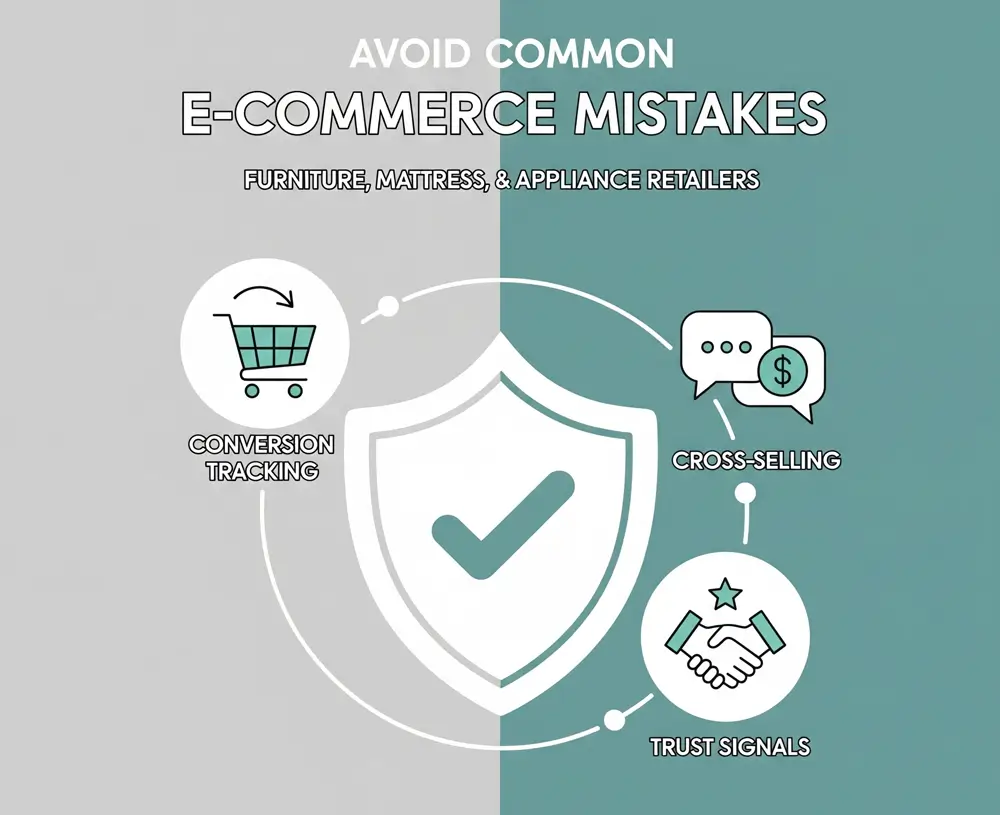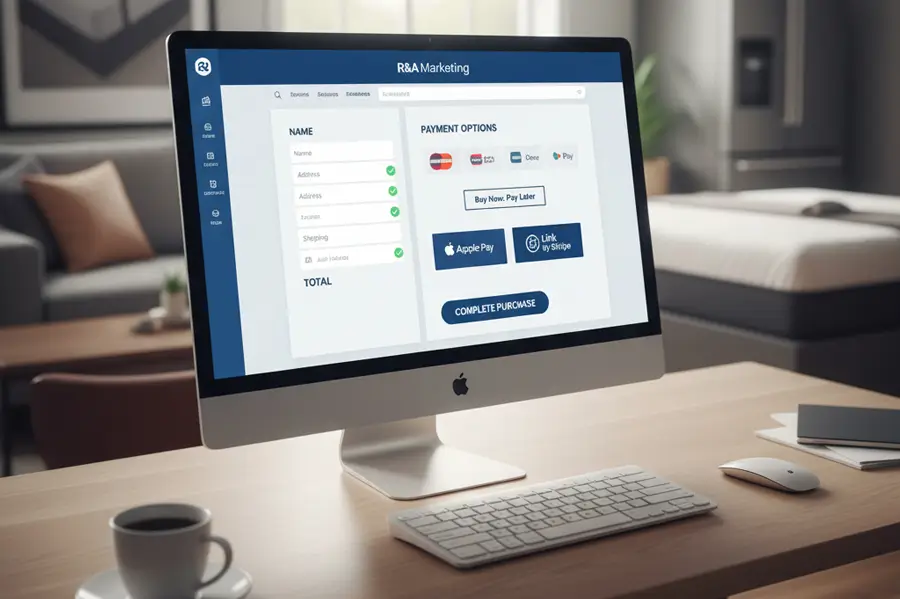The digital showroom is now just as crucial as your physical one. Customers browse, compare, and often purchase high-ticket items like sofas, mattresses, and refrigerators online. But with this opportunity comes a new set of challenges. In this guide, we’re covering the top mistakes store owners make. Whether you’re launching a new store, or looking to improve an existing one, there are some things you might want to avoid.
Mistake 1: Missing Cross-Sell and Upsell Opportunities
The Mistake: Failing to set up cross-sells and up-sells results in missed opportunities to increase your store’s average order value (AOV). By not recommending relevant items, add-ons, or upgrades, store owners miss a simple yet powerful way to boost revenue without additional traffic.
How to Avoid It: Think like your best in-store salesperson. What would they recommend? A customer buying a mattress should always be shown a mattress protector and premium pillows. Someone purchasing a new sofa might need an ottoman or a rug to complete the room. An appliance buyer could benefit from an extended warranty or the necessary installation kit.
- Automate Recommendations: Use your e-commerce platform’s features to automatically suggest related products on the product page and in the cart.
- Create Bundles: Offer a “Living Room Package” or a “Laundry Pair” at a slight discount to encourage larger purchases.
- Upsell Smartly: When a customer views a queen mattress, show them the king version as an upgrade. Display the performance fabric option for the sofa they’re considering.
Implementing these strategies is a core part of a high-performing website design that turns browsers into bigger buyers.
Mistake 2: Not Using the Thank You/Order Complete Page Effectively
The Mistake: The thank you page is often overlooked as a prime opportunity to engage customers. Many store owners simply confirm the order, missing a valuable space to encourage return visits, highlight special offers, and recommend additional products.
How to Avoid It: The order confirmation page is prime real estate. You have the full attention of a happy customer who just trusted you with their money. Use this moment to strengthen the relationship.
- Offer a Future Discount: Provide a coupon code for 10% off their next purchase to encourage repeat business.
- Ask for a Referral or Review: Prompt them to share their experience on social media or leave a product review.
- Promote Your Content: Link to a blog post about how to care for their new purchase, such as “5 Tips to Keep Your New Sectional Looking Brand New.”
Mistake 3: Not Fully Utilizing the Short and Long Description Fields
The Mistake: Relying on just one description field limits your ability to convey the full value of your product and can impact your store’s SEO performance. Both the short and long description fields serve distinct purposes and, when used together, can significantly enhance product pages.
How to Avoid It: Think of the two fields as serving two different types of shoppers: the scanner and the researcher.
- The Short Description (For the Scanner): This should be a quick, scannable list of the most important features and benefits. Use bullet points to highlight key specs like “Solid Wood Construction,” “Energy Star Certified,” or “10-Year Warranty.” This is your elevator pitch.
- The Long Description (For the Researcher): This is where you tell the story. Describe the craftsmanship, the comfort, and how this piece will fit into the customer’s home and lifestyle. Use detailed specifications, dimensions, and care instructions. This is also where you should naturally weave in important keywords to improve your store’s SEO (Search Engine Optimization).
Mistake 4: Missing Out on Conversion Tracking in Analytics
The Mistake: Running Google Analytics without conversion tracking means you’re missing out on crucial insights into customer behavior and which channels are actually driving your sales. Without this data, it’s difficult to understand what’s working – and what isn’t – in your marketing strategy.
How to Avoid It: Operating without conversion tracking is like running a sales flyer without a phone number—you have no idea if it’s working. Setting this up is non-negotiable for making smart business decisions.
- Implement E-commerce Tracking: Ensure Google Analytics is properly configured to track not just visits, but transactions, revenue, and AOV.
- Identify Your ROI: With tracking, you can see exactly which channels (e.g., Google Ads, Facebook, email marketing) are generating sales. This allows you to stop wasting money on what isn’t working and double down on what is.
- Analyze the Full Funnel: See where customers are dropping off in the checkout process, allowing you to identify and fix potential issues. A robust digital marketing strategy is built on this kind of data.
Mistake 5: Not Setting Up Proper Shipping Methods
The Mistake: Many store owners overlook setting up accurate shipping methods, which can lead to customer frustration at checkout if shipping options don’t match their expectations. This oversight can result in lost sales if customers feel that delivery is inconvenient or unclear. Make sure it matches the same delivery costs you would offer in-store.
How to Avoid It: For furniture and appliances, shipping is not an afterthought; it’s a core part of the product. Ambiguity here will kill conversions faster than anything.
- Be Transparent: Clearly define your delivery options before the checkout page. List services like Curbside Delivery, Threshold Delivery, Room of Choice, and White-Glove Delivery with Assembly.
- Provide Accurate Costs: Nothing causes cart abandonment like a surprise $200 delivery fee on the final step. Integrate a shipping calculator or have clear, flat rates based on product type or zip code.
- Offer Options: Customers value choice. Providing different service tiers at different price points allows them to select the option that best fits their budget and needs.
Mistake 6: Neglecting Trust Signals on Product and Checkout Pages
The Mistake: A lack of visible trust signals on product and checkout pages can reduce customer confidence, leading to lower conversion rates and more abandoned carts. Without these elements, customers may hesitate, unsure about the legitimacy and reliability of your store.
How to Avoid It: A customer is about to make a significant purchase. You must make them feel completely secure in their decision.
- Display Security Badges: Prominently show SSL certificate badges and accepted payment logos (Visa, PayPal, Affirm, etc.) to reassure customers their data is safe.
- Showcase Social Proof: Customer reviews and star ratings are one of the most powerful trust signals. Feature them directly on your product pages.
- Be Accessible: Make your physical address, customer service phone number, and return policy easy to find. This shows you’re a real, accountable business ready to stand behind your products.
Take Your Online Showroom to the Next Level
Learn from these mistakes and optimize your online showroom. Running a successful online showroom is all about creating a seamless, trustworthy, and engaging experience that encourages customers to buy and return. By addressing these common pitfalls, you can improve customer satisfaction, increase your average order value, and build a stronger, more profitable online presence.
Feeling overwhelmed by the complexities of your online showroom? You don’t have to navigate the digital world alone. At R&A Marketing, we specialize in helping furniture, mattress, and appliance retailers thrive in today’s digitally dominated shopping landscape.
Schedule a meeting with us today to learn how we can help you avoid these mistakes and build an e-commerce strategy that delivers real results.
















